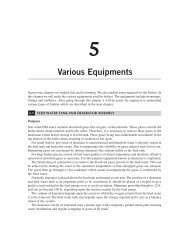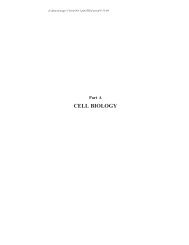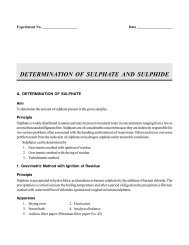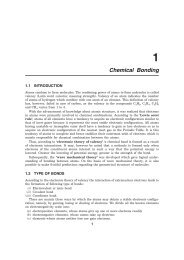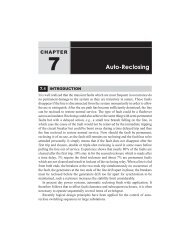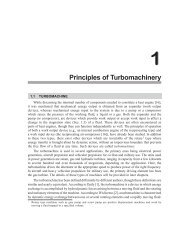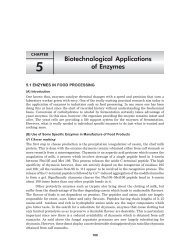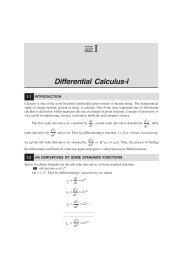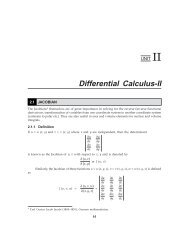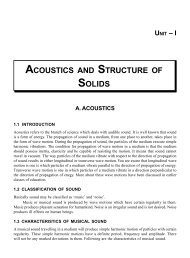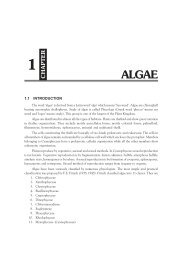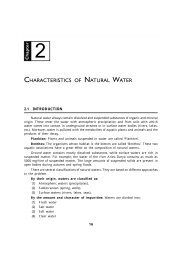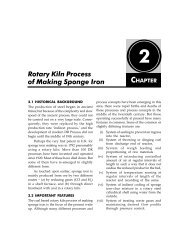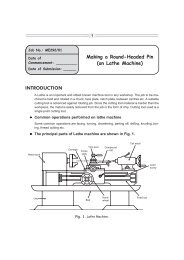Important Text & MCQs Chapterwise Arranged - New Age International
Important Text & MCQs Chapterwise Arranged - New Age International
Important Text & MCQs Chapterwise Arranged - New Age International
Create successful ePaper yourself
Turn your PDF publications into a flip-book with our unique Google optimized e-Paper software.
SECTION-I<br />
<strong>Important</strong> <strong>Text</strong><br />
&<br />
<strong>MCQs</strong> <strong>Chapterwise</strong> <strong>Arranged</strong>
CHAPTER<br />
1<br />
m Mental health is a state of psychological well<br />
being or adequate adjustment, particularly as such<br />
adjustment conforms to the community accepted<br />
standards of behaviour.<br />
m Psychoanalysis is a form of procedure (for investigating<br />
mental processes), a theory and a form of<br />
treatment developed by Sigmund Freud.<br />
m Average prevalence of severe mental disorders in<br />
India is 18-20/1000 population.<br />
m Average incidence of serious mental disorders is<br />
35 per lac population<br />
m About 1-2% of children suffer from learning and<br />
behaviour problems.<br />
General Psychiatry<br />
<strong>Important</strong> Characteristics of Mental Health<br />
m Mental retardation is estimated to be present in<br />
0.5-1.0% of all children.<br />
m Depressive neurosis is the most frequent psychiatric<br />
disorder in India (Neuroses constitute about<br />
two third cases), followed by anxiety neurosis.<br />
Depression is the commonest geriatric<br />
psychiatric problem (i.e. 60/1000)<br />
m Schizophrenia utilizes most of the psychiatric<br />
beds available in India.<br />
m In India, we have about 2000-2500 qualified<br />
psychiatrists, 600-700 psychologists, 300-400<br />
psychiatric social workers and 500-600 psychiatric<br />
nurses.<br />
Reasonable independence Ability to show friendliness and love<br />
Self-reliance Ability to give and take<br />
Self-direction Tolerance of others and of frustration and<br />
Ability to do a job emotions<br />
Ability to take responsibility and Ability to contribute<br />
make needed efforts A sense of humor<br />
Reliability A devotion beyond oneself<br />
Persistence Ability to get along with others<br />
Ability to find recreation, as in hobbies (capacity for intimacy)<br />
Satisfaction with sexual identity Cooperation<br />
Ability to work under authority, Optimism<br />
rules and difficulties Ability to function in both dependent and<br />
A sense of competition, collaboration independent roles<br />
compromise satisfaction and security
4 Psychiatry Review<br />
1. The number of new cases of serious mental<br />
disorders which become manifest each year<br />
(incidence) per lac population is approximately:<br />
A. 5 B. 10<br />
C. 25 D. 35<br />
2. The commonest psychiatric illness in world is:<br />
A. Schizophrenia<br />
B. Endogenous depression<br />
C. Anxiety neurosis D. Exogenous depression<br />
3. The commonest psychiatric disorder among elderly<br />
in India is:<br />
A. Dementia B. Delirium<br />
C. Depression D. Suicide<br />
4. Ethology is:<br />
A. Studying of interaction between animals and<br />
human being<br />
B. Study of animal behaviour in natural habitat<br />
C. Study of animals under controlled laboratory<br />
conditions<br />
D. None of the above<br />
5. The following psychiatric disorders are more<br />
common in females except:<br />
A. MDP depression B. Transvestism<br />
C. Social phobia D. Anorexia nervosa<br />
6. Ethology has made major contributions to understand<br />
human behaviour through all the following<br />
concepts except:<br />
A. Fixed action pattern and “sign stimulus”<br />
B. Critical period<br />
C. Ethnic bonds<br />
D. Imprinting<br />
7. Estimated prevalence of neurosis in the community<br />
is about:<br />
A. 0–5% B. 5–10%<br />
C. 10–20% D. 20–40%<br />
8. Number of cases of psychoses expected per<br />
thousand population:<br />
<strong>MCQs</strong><br />
ANSWERS<br />
A. Less than one B. 1–5<br />
C. 6–10 D. 11–20<br />
9. Mental disorders are:<br />
A. Adaptive and Reparative<br />
B. Protective<br />
C. Defensive<br />
D. All of the above<br />
10. A psychiatric illness may be marked by all of the<br />
following except:<br />
A. Disturbance in behaviour<br />
B. Impairment in preexisting functioning<br />
C. Impoverishment of feelings<br />
D. Unpopular beliefs<br />
11. Epileptic fit and hysterical fit can be certainly<br />
differentiated by:<br />
A. Duration of fit B. Frothing from mouth<br />
C. Incontinence of urine<br />
D. Injury during fit<br />
12. The commonest mental illness in children is:<br />
A. Mental retardation B. Infantile autism<br />
C. Enuresis D. Neuroses<br />
13. Prevalence of mentally ill patients in India is at<br />
least:<br />
A. 1–5/1000 B. 5–10/1000<br />
C. 10–20/1000 D. 100–200/1000<br />
14. The commonest psychotic illness in India is:<br />
A. Schizophrenia<br />
B. Endogenous depression<br />
C. Mania D. Dementia<br />
15. Commonest psychiatric illness in India is:<br />
A. Schizophrenia<br />
B. Endogenous depression<br />
C. Mixed Anxiety Depressive Disorder<br />
D. Anxiety neurosis<br />
16. The prevalence of severely mentally retarded in<br />
India is:<br />
A. 1–2/1000 B. 5–10/1000<br />
C. 10–15/1000 D. 15–20/1000<br />
1. D 2. C 3. C 4. B 5. B 6. C 7. B 8. B 9. D 10. D<br />
11. C 12. D 13. C 14. B 15. C 16. A
CHAPTER<br />
2<br />
m Sigmund Freud (1856-1939): Austrian psychiatrist,<br />
Founder (father) of Psychoanalysis, gave<br />
topographical theory of mind (unconscious,<br />
preconscious and conscious) and its structure (Id,<br />
Ego, Supergo); described stages of psychosexual<br />
development (oral anal, phallic (oedipal), latent<br />
and genital); oedipal complex; Interpretation<br />
of dreams; concepts of libido, regression,<br />
transference, sublimation and repression; took and<br />
described properties of cocaine.<br />
m Alfred Adler (1875-1937): Austrian psychiatrist,<br />
gave concepts of inferiority complex (superiority<br />
drive), overcompensation and founded school of<br />
Individual Psychology.<br />
m Carl Gustav Jung (1875-1961): gave concepts of<br />
Collective unconscious, archetypes, personality<br />
types (introvert and extrovert), anima animus,<br />
persona and founded school of analytic psychology.<br />
m Philipe Pinel is known as the father of modern<br />
psychiatry (he founded humane approach for<br />
treating mentally-ill persons)<br />
m Felix Platter wrote the first psychiatric textbook<br />
(Praxis Medica)<br />
m Johann Reil first used the word “psychiatry”<br />
whereas Gockel coined the word “psychology”.<br />
m Julius Wagner von Jauregg was first<br />
psychiatrist to get Nobel Prize for malarial<br />
therapy of GPI.<br />
m First drug introduced in psychiatry : — among<br />
Major tranquilizers or antipsychotics<br />
(chlorpromazine), butyrophenones (haloperiodol),<br />
History of psychiatry<br />
antidepressants (iproniazid, a MAOI), benzodiazepines<br />
(chlordiazepoxide).<br />
m Atreya was the first great Indian Physician.<br />
m First Asylum in India was built in Bombay.<br />
m Indian Lunacy Act (1912) has been replaced by<br />
Mental Health Act (of 1987); Narcotic Drugs<br />
and Psychotropic Substances Act was passed<br />
in 1985 and National Mental Health<br />
Programme was launched in 1982.<br />
Some Contributors to the Development of<br />
Therapies<br />
I. Organic Therapies<br />
W. Oliver (1785) – Camphor induced convulsions<br />
in Melancholia<br />
Wagner von Jauregg– Malarial treatment in<br />
(1917) General Paresis of Insane<br />
Kalesi (1922) – Prolonged Narcosis<br />
therapy<br />
Steck (1932) – First used insulin in acute<br />
Psychosis<br />
Sakel (1933) – Insulin Coma therapy<br />
Meduna (1930s) – Cardiazol or Metrazol<br />
convulsive therapy<br />
Friedman and Wilcox – Unilateral Electroconvulsive<br />
(1942) therapy<br />
P. Dalmas-Marsolet – Continuous stimulation<br />
(1942) therapy<br />
Egas Moniz (1936) – Psychosurgery (Perfrontal<br />
lobotomy) and also carotid<br />
Angiography
6 Psychiatry Review<br />
Schulte (1950) – Sleep deprivation therapy<br />
Fiamberti (1937) – Acetylcholine<br />
Lovenhart et al – Carbon dioxide Therapy<br />
(1926)<br />
Hoch (1930s) – Atropine therapy<br />
Kielholz – Blood transfusion and<br />
hemodialysis for treatement<br />
of mental illness<br />
Deschamps (1952) – Artificial hibernation<br />
(Refrigeration therapy)<br />
Talbot and Tillotson – Hypothermia<br />
Cossa and Gastuat – Photoshock therapy<br />
Delay et al – Cerebral Pneumotherapy<br />
(Suboccipital)<br />
Blackwenn – Narcotherapy (Using<br />
Sodium Amytal)<br />
Kane and di Scipio – Acupuncture in mental<br />
illness<br />
Cerletli – Acroagonine (a substance<br />
which appears after ECT<br />
in brain) therapy<br />
Zador (1928) – Nitrous Oxide inhalation<br />
therapy<br />
Sargant and Slater – Ether Abreaction therapy<br />
II. Psychological Therapies<br />
Sigmund Freud – Psychoanalysis and Free<br />
association.<br />
Carl C. Rogers – Client Oriented Psychotherapy<br />
Frederich Perls – Gestalt therapy.<br />
Erich Berne – Transactional analysis<br />
Victor E. Frankl – Existential logotherapy<br />
James Braid – Neuro-hypnotism<br />
Albert Ellis – Rational Emotive therapy<br />
William Glasser – Reality therapy<br />
Arthur Janov – Primal therapy<br />
J.L. Moreno – Psychodrama<br />
Assagioli – Psychosynthesis<br />
Maslow – Self Actualization<br />
Pietro Pisani – Millieu therapy<br />
Aaron Beck – Cognitive therapy (in<br />
depression)<br />
T.F Main and – Therapeutic communities<br />
Maxwell Jones<br />
John Watson – Behaviorism<br />
Ivan Pavlov – Classical conditioning<br />
Joseph Wolpe – Systematic desensitization<br />
B.F. Skinner – Operant conditioning<br />
Joint commission on – Deinstitutionalization.<br />
Mental Illness (in USA)<br />
Some Contributors to the Development of<br />
Drug Treatment<br />
Hippocrates – Herbal remedies for mental<br />
illness<br />
Fisher (1903) – Synthesized first barbiturate<br />
Sen and Bose (1931) – Used rauwolfia extract in<br />
major Psychosis<br />
Bernthsen (1883) – Synthesized chlorpromazine<br />
Charpentier (1950) – Described properties of<br />
chlorpromazine<br />
Delay, Deniker and – Use of chlorpromazine to<br />
Harl (1952) treat certain psychotic<br />
symptoms and coined term<br />
‘Neuroleptic’<br />
Cade (1949) – Lithum<br />
Zeller (1952) – Described Iproniazid<br />
(a MAO inhibitor) as an<br />
antidepressant<br />
Janssen et al (1958) – Synthesized large number<br />
of butyrophenones<br />
Divry et al (1958) – Described properties of a<br />
number of butyrophenones<br />
Kuhn (1957) – Described properties of<br />
imipramine<br />
Haflinger and Schindler– Synthesized imipramine<br />
(1957)<br />
Sternbach – Discovery of chlordiazepoxide<br />
Cohen (1960) – Described properties of<br />
chlordiazepoxide<br />
Hoffer and Osmond – Megavitamin therapy<br />
(1954) (niacin + Vit.C + Penicillin)<br />
Hald et al (1948) – Disulfiram (antabuse)<br />
Ferguson (1956) – Calcium carbide cause<br />
reaction like antabuse<br />
Taylor et al (1964) – Metronidazole causes<br />
Antabuse like reactions<br />
Osterman et al (1959) – Chlormethiazole (used in<br />
alcohol withdrawal<br />
symptom)
History of Psychiatry 7<br />
1. The word ‘Social Psychiatry’ was coined by:<br />
A. Franz Alexander B. S.R. Slavson<br />
C. Thomas Rennie D. Konrad Lorenz<br />
2. Match the following:<br />
I. Cade (i) Chlorpromazine<br />
II. Cohen (ii) Chlordiazepoxide<br />
III. Hoffman (iii) Lithium<br />
IV. Delay and Deniker (iv) Lysergic acid<br />
A. I (ii) II (iii) III (iv) IV (i)<br />
B. I (i) II (ii) III (iv) IV (iii)<br />
C. I (iii) II (ii) III (iv) IV (i)<br />
D. I (iii) II (iv) III (ii) IV (i)<br />
3. Match the following:<br />
Stage of Psychosocial<br />
Development<br />
Conflict<br />
I. Oral (i) Autonomy<br />
shame<br />
versus<br />
II. Anal (ii) Initiative versus guilt<br />
III. Genital (iii) Industry versus<br />
inferiority<br />
IV. Latent (iv) Trust versus mistrust<br />
A. I (i) II (ii) III (iv) IV (iii)<br />
B. I (iv) II (ii) III (i) IV (iii)<br />
C. I (iv) II (i) III (ii) IV (iii)<br />
D. I (iv) II (iii) III (ii) IV (i)<br />
4. “Hallucination is a perception without a stimulus”<br />
(false perception)” was said by:<br />
A. Bleuler B. Janet<br />
C. Schneider D. Esquirol<br />
5. Which of the following is a topographical model of<br />
mind by Freud:<br />
A. Id-Ego-Superego<br />
B. Unconscious-Preconscious-Conscious<br />
C. Regression-Repression-Suppression<br />
D. Denial-Rationalization-Projection<br />
6. The definition of hallucination “It is a false<br />
perception, which is not a sensory distortion, or<br />
misinterpretation but which occurs at the same<br />
time as real perceptions”, was given by:<br />
<strong>MCQs</strong><br />
A. Esquirol B. Jaspers<br />
C. Bleuler D. Schneider<br />
7. Who has been often called as the “First<br />
Psychiatrist”:<br />
A. Paracelsus B. Hippocrates<br />
C. John Weyer D. Sigmund Freud<br />
8. Match the following:<br />
I. Morselli (i) Hypnosis<br />
II. James Baird (ii) Schizoaffective<br />
III. Kahlbaum (iii) Dysmorphophobia<br />
IV. Kasanin (iv) Paranoia<br />
A. I (ii) II (iii) III (iv) IV (i)<br />
B. I (i) II (ii) III (iii) IV (iv)<br />
C. I (ii) II (i) III (iii) IV (iv)<br />
D. I (iii) II (i) III (iv) IV (ii)<br />
9. The term “Ambivalence” was coined by:<br />
A. Hippocrates B. Eugen Bleuler<br />
C. Kraepelin D. Sigmund Freud<br />
10. ‘God complex’-a belief sometimes in therapists that<br />
one, can accomplish more than is humanly possible<br />
or that one’s word should not be doubted, was first<br />
discussed by:<br />
A. Sigmund Freud B. Erik Erikson<br />
C. Joseph Breuer<br />
11. Match the following:<br />
D. Ernest Jones<br />
I. Clifford Beers (i) Psychopathia sexualis<br />
II. Otto Rank (ii) Major studies of<br />
III. Eril Erikson<br />
Luther and Gandhi<br />
(iii) A mind that found<br />
itself<br />
IV. R. Kraft Ebing (iv) The trauma of birth<br />
A. I (i) II (ii) III (iii) IV (iv)<br />
B. I (ii) II (iii) III (iv) IV (i)<br />
C. I (iii) II (iv) III (ii) IV (i)<br />
D. I (iii) II (ii) III (iv) IV (i)<br />
12. The term “Style of life” was coined by:<br />
A. Sigmund Freud B. Alfred Adler<br />
C. Karen Horney D. Eric Berne
8 Psychiatry Review<br />
13. The concept of “Experimental Neurosis” was given<br />
by:<br />
A. Sigmund Freud B. Karen Horney<br />
C. Ivan P. Pavlov D. Frederic B. Skinner<br />
14. The first of the benzodiazepines, synthesized in 1957<br />
was:<br />
A. Diazepam B. Chlordiazepoxide<br />
C. Chloral hydrate D. Lorazepam<br />
15. All of the following are Neo-Freudians except:<br />
A. Anna Freud B. H.S. Sullivan<br />
C. Melanie Klein D. Erik Erikson<br />
16. The important work “The Ego and the Mechanisms<br />
of Defense” is attributed to:<br />
A. Sigmund Freud B. Anna Freud<br />
C. Alfred Adler D. Carl C. Jung<br />
17. First mental hospital was founded in:<br />
A. USA B. UK<br />
C. Spain D. France<br />
18. First mental hospital was said to be founded by:<br />
A. Juan C. Duarte B. Gilbert Jofre<br />
C. Philippe Pinel D. William Tuke<br />
19. The term “therapeutic community” was introduced<br />
by:<br />
A. Charles Dederich B. Tom Main<br />
C. Maxwell Jones D. Cliford Beers<br />
20. In Freudian theory, Oedipus complex is seen in<br />
which stage of the psychosexual development:<br />
A. Anal B. Urethral<br />
C. Genital<br />
21. Match the following:<br />
D. Latent<br />
I. Esquirol (i) Pseudohallucinations<br />
II. Hagen (ii) Apperceptive<br />
hallucination<br />
III. Kahlbaum (iii) Pale hallucinations<br />
IV. Griesinger (iv) Hallucination<br />
A. I (i) II (ii) III (iii) IV (iv)<br />
B. I (iii) II (iv) III (i) IV (ii)<br />
C. I (iv) II (i) III (ii) IV (iii)<br />
D. I (iv) II (ii) III (iii) IV (i)<br />
22. All of the following are the characteristics of<br />
hypnagogic hallucinations except:<br />
A. Occur during drowsiness<br />
B. Are discontinuous<br />
C. Appear to force themselves on the subject<br />
D. Form a part of an experience in which the<br />
subject participates<br />
23. Sigmund Freud is famous for:<br />
A. Structure of brain B. Inferiority complex<br />
C. Behaviour therapy D. None of the above<br />
24. Oedipus complex (given by Sigmund Freud) is seen<br />
in:<br />
A. Boys of 1–3 years of age<br />
B. Girls of 1–3 years of age<br />
C. Boys of 3–5 years of age<br />
D. Girls of 3–5 years of age<br />
25. Life span of Sigmund Freud was:<br />
A. 1836–1919 B. 1946–1929<br />
C. 1856–1939 D. 1865–1934<br />
26. Sigmund Freud passed most of his life in:<br />
A. USA B. Germany<br />
C. Austria D. France<br />
27. Defect of conation is typically seen in:<br />
A. Simple schizophrenia<br />
B. Hebephrenic schizophrenia<br />
C. Catatonic schizophrenia<br />
D. Paranoid schizophrenia<br />
28. Auditory hallucinations in clear consciousness is<br />
seen in:<br />
A. Senile dementia<br />
B. Multiinfarct dementia<br />
C. Alcoholic hallucinosis<br />
D. Alcoholic intoxication<br />
29. Which of the following is a wrong matching:<br />
A. Waegner-Malaria treatment in GPI<br />
B. Meduna-Convulsive therapy<br />
C. Sakel-Insulin coma<br />
D. Adler-Superiority complex<br />
30. “Body-Mind dualism”, was written by:<br />
A. Pierre Janet B. Sullivan<br />
C. Anna Freud D. Rene Descartes
History of Psychiatry 9<br />
31. Match the following:<br />
I. Hallopeau (i) ‘Babel of Tongues’<br />
(Problems in communicating<br />
among<br />
psychiatrists)<br />
II. Pinel and Esquirol (ii) Kleptomania<br />
III. Marc (iii) Instinctive monomania<br />
IV. William Meninger (iv) Trichotillomania<br />
A. I (ii) II (iii) III (iv) IV (i)<br />
B. I (iii) II (iv) III (ii) IV (i)<br />
C. I (iv) II (iii) III (ii) IV (i)<br />
D. I (iv) II (i) III (ii) IV (iii)<br />
32. Match the following:<br />
I. Gockel (i) First mental hospital in<br />
Valencia<br />
II. Paolo Zacchia (ii) First Psychiatric book<br />
(Praxis Medica)<br />
III. Felix Platter (iii) Father of legal<br />
medicine<br />
IV. Gilbert Jofre (iv) Coined word<br />
“Psychology”<br />
A. I (i) II (iv) III (iii) IV (ii)<br />
B. I (ii) II (i) III (iv) IV (iii)<br />
C. I (iii) II (ii) III (i) IV (iv)<br />
D. I (iv) II (iii) III (ii) IV (i)<br />
33. Which of the following is not a contribution of<br />
Sigmund Freud:<br />
A. Effects of cocaine<br />
B. Interpretation of dreams<br />
C. Psychosexual stages of development<br />
D. Superiority-Inferiority complex<br />
34. First antipsychotic drug introduced was:<br />
A. Chlorpromazine B. Haloperidol<br />
C. Trifluoperazine D. Lithium<br />
35. The latency phase of psychoanalytic theory occurs<br />
at the same time at which of the following<br />
Erikson’s stages?<br />
A. Trust vs mistrust<br />
B. Identity vs role confusion<br />
C. Industry vs inferiority<br />
D. Autonomy vs shame & doubt<br />
36. Match the following:<br />
I. Oral stage (i) Shame, ambivalence<br />
and personal achievement<br />
II. Anal stage (ii) Tendency and autoeroticism<br />
III. Genital stage (iii) Swings between asceticism,<br />
eroticism and altruism<br />
IV. Latency (iv) Strong patterning after<br />
heroes and limited sexual<br />
curiosity<br />
V. Puberty (v) Castration complex develop<br />
A. I (i) II (ii) III (iii) IV (iv) V (v)<br />
B. I (ii) II (i) III (v) IV (iv) V (iii)<br />
C. I (ii) II (iii) III (iv) IV (v) V (i)<br />
D. I (iii) II (iv) III (v) IV (i) V (ii)<br />
37. Match the following:<br />
I. Bibring (i) Depression, is a<br />
conflict within ego<br />
rather than between<br />
ego and super-ego is<br />
associated with loss of<br />
self-esteem<br />
II. Abraham (ii) Melancholia is a<br />
III. Melanie Klien<br />
despairing cry for love<br />
(iii) Inability to solve the<br />
normal depressive<br />
IV. Sigmund Freud<br />
position leads in later<br />
life to depression<br />
(iv) In mania-there is<br />
fusion of ego and<br />
super ego while in<br />
melancholia, there is<br />
an incorporation of<br />
ambivalently loved lost<br />
object<br />
V. Rado (v) Compared melancholic<br />
depression with grief<br />
A. I (i) II (v) III (iii) IV (iv) V (ii)<br />
B. I (i) II (ii) III (iii) IV (iv) V (v)<br />
C. I (ii) II (i) III (v) IV (iii) V (iv)<br />
D. I (i) II (v) III (iv) IV (iii) V (ii)<br />
38. Moral treatment of mentally ill patients was first<br />
stressed by:<br />
A. Pinel B. Morel<br />
C. Kraepelin D. Sigmund Freud
10 Psychiatry Review<br />
39. The classification of hallucinosis into confusional,<br />
self reference, verbal and fantastic was given by:<br />
A. Jaspers B. Sedman<br />
C. Hagen D. Schroeder<br />
40. Pick up wrong matching:<br />
A. Freud - Cocaine B. Cade - Lithium<br />
C. Adler - Imipramine<br />
D. Cerletti and Bini - ECT<br />
41. Oedipus complex is seen in:<br />
A. A male child towards mother<br />
B. A female child towards mother<br />
C. Mother towards male child<br />
D. Mother towards female child<br />
42. Delusion is a disorder of:<br />
A. Cognition B. Conation<br />
C. Will D. Affect<br />
43. Freud was born in:<br />
A. 1836 B. 1856<br />
C. 1896 D. 1902<br />
44. ‘Elektra (Electra) complex’ a term first used by:<br />
A. Sigmund Freud B. Anna Freud<br />
C. Janet D. Melanie Klein<br />
45. Which of the following types of ambivalence was<br />
not given by Bleuler:<br />
A. Ambivalence of will<br />
B. Ambivalence of thinking<br />
C. Affective ambivalence<br />
D. Ambivalence of act<br />
46. Pavlov is associated with:<br />
A. Operant conditioning<br />
B. Classical conditioning<br />
C. Inferiority complex<br />
D. Habit disorders<br />
47. Pick up wrong matching:<br />
A. Freud - Cocaine<br />
B. Delay & Deniker – chlorpromazine<br />
C. Kuhn - Imipramine<br />
D. Janssen - Haloperidol<br />
48. Pick the wrong match:<br />
A. Phillipe Pinel - Psychiatric reforms<br />
B. Emile Kraepelin - Early study of schizophrenia<br />
C. Sigmund Freud - Dream analysis<br />
D. Joseph Wolpe - Test of intelligence<br />
49. Match the following classifications and authors:<br />
I. Dimensional (i) Pavolv and Skinner<br />
II. Typological or (ii) <strong>International</strong><br />
categorical Classification of<br />
Diseases (ICD-9),<br />
WHO<br />
III. Multiaxial (iii) Rutter’s<br />
IV. Behavioural (iv) Eysenck<br />
A. I (i) II (ii) III (iii) IV (iv)<br />
B. I (iii) II (ii) III (i) IV (iv)<br />
C. I (iv) II (ii) III (iii) IV (i)<br />
D. I (iv) II (iii) III (ii) IV (i)<br />
50. All of the following were Post-Freudians (“Human<br />
Potential Movement or Growth therapies”) except:<br />
A. Winnicot B. Erikson<br />
C. Carl Rogers D. Bowlby<br />
51. All of the following were said to be Neo-Freudians<br />
except:<br />
A. Horney B. Anna Freud<br />
C. Melanie Klein D. Eric Berne<br />
52. Theory of control and communication between man<br />
and machine is :<br />
A. Primal therapy B. Existential logotherapy<br />
C. Basic Encounters D. Cybernatics<br />
53. First Neurotransmitter discovered was:<br />
A. Norepinephrine B. Dopamine<br />
C. Serotonin D. Acetylcholine<br />
54. Sigmund Freud opined that ‘Religious ideas’ are:<br />
A. Delusions B. Overvalued ideas<br />
C. Illusions D. Hallucinations<br />
55. According to Sigmund Freud, all of the following<br />
are the Ego’s defence mechanisms except:<br />
A. Restitution B. Reversal<br />
C. Regression D. None of the above<br />
56. Superego differs from the conscience in that :<br />
A. It belongs to a different frame of reference i.e.<br />
metapsychology not ethics.<br />
B. It includes unconscious elements<br />
C. Injections and inhibitions emanating from the<br />
subject’s past and may be conflict with his<br />
present values<br />
D. All of the above



